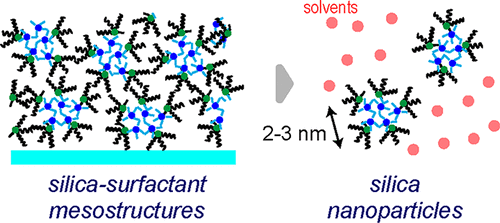Our official English website, www.x-mol.net, welcomes your
feedback! (Note: you will need to create a separate account there.)
Formation of Single-Digit Nanometer Scale Silica Nanoparticles by Evaporation-Induced Self-Assembly
Langmuir ( IF 3.7 ) Pub Date : 2018-01-09 00:00:00 , DOI: 10.1021/acs.langmuir.7b04042 Shigeru Sakamoto 1 , Masashi Yoshikawa 1 , Kota Ozawa 1 , Yoshiyuki Kuroda 2 , Atsushi Shimojima 1 , Kazuyuki Kuroda 1, 3
Langmuir ( IF 3.7 ) Pub Date : 2018-01-09 00:00:00 , DOI: 10.1021/acs.langmuir.7b04042 Shigeru Sakamoto 1 , Masashi Yoshikawa 1 , Kota Ozawa 1 , Yoshiyuki Kuroda 2 , Atsushi Shimojima 1 , Kazuyuki Kuroda 1, 3
Affiliation

|
There are emerging demands for single-digit nanoscale particles in multidisciplinary fields, such as nanomedicine, optics, catalysis, and sensors, to create new functional materials. Here, we report a novel route to prepare silica nanoparticles less than 3 nm in size via the evaporation-induced self-assembly of silicate species and quaternary trialkylmethylammonium surfactants, which usually form reverse micelles. The solvent evaporation induces a local concentration increase and simultaneous polycondensation of silicate species within the hydrophilic region of the surfactant mesophases. Extremely small silica nanoparticles in the silica–surfactant mesostructures can be stably dispersed in organic solvents by destroying the mesostructure, which is in clear contrast to the preparation of silica nanoparticles using the conventional reverse micelle method. The surface chemical modification of the formed silica nanoparticles is easily performed by trimethylsilylation. The particle size is adjustable by changing the ratio of the surfactants to the silica source because the hydrophobic/hydrophilic ratio determines the curvature and diameter of the resulting spherical silica–surfactant domains in the mesostructure. The versatility of this method is demonstrated by the fabrication of very small titania nanoparticles. These findings will increase the designability of oxide nanoparticles at the single-digit nanoscale because conventional methods based on the generation and growth of nuclei in a solution cannot produce such nanoparticles with highly regulated sizes.
中文翻译:

蒸发诱导自组装形成单位纳米级二氧化硅纳米粒子
在多学科领域,诸如纳米医学,光学,催化和传感器,对产生一位数的纳米级颗粒提出了新的要求,以产生新的功能材料。在这里,我们报告了一种新颖的途径,可通过蒸发诱导的硅酸盐物质和季三烷基甲基铵表面活性剂(通常形成反胶束)的自组装来制备尺寸小于3 nm的二氧化硅纳米颗粒。溶剂蒸发引起表面活性剂中间相的亲水区内的硅酸盐种类的局部浓度增加和同时缩聚。可以通过破坏介孔结构将二氧化硅-表面活性剂介孔结构中的极小的二氧化硅纳米颗粒稳定地分散在有机溶剂中,这与使用常规反胶束法制备二氧化硅纳米粒子形成鲜明对比。形成的二氧化硅纳米粒子的表面化学改性可通过三甲基甲硅烷基化容易地进行。可通过改变表面活性剂与二氧化硅源的比例来调节粒径,因为疏水/亲水比决定了介孔结构中所得球形二氧化硅-表面活性剂域的曲率和直径。通过制备非常小的二氧化钛纳米颗粒证明了该方法的多功能性。这些发现将提高单位面积纳米级氧化物纳米颗粒的可设计性,因为基于溶液中核的生成和生长的常规方法无法生产尺寸高度受控的纳米颗粒。形成的二氧化硅纳米粒子的表面化学改性可通过三甲基甲硅烷基化容易地进行。可通过改变表面活性剂与二氧化硅源的比例来调节粒径,因为疏水/亲水比决定了介孔结构中所得球形二氧化硅-表面活性剂域的曲率和直径。通过制备非常小的二氧化钛纳米颗粒证明了该方法的多功能性。这些发现将提高单位面积纳米级氧化物纳米颗粒的可设计性,因为基于溶液中核的生成和生长的常规方法无法生产出尺寸受到严格控制的纳米颗粒。形成的二氧化硅纳米粒子的表面化学改性可通过三甲基甲硅烷基化容易地进行。可通过改变表面活性剂与二氧化硅源的比例来调节粒径,因为疏水/亲水比决定了介孔结构中所得球形二氧化硅-表面活性剂域的曲率和直径。通过制备非常小的二氧化钛纳米颗粒证明了该方法的多功能性。这些发现将提高单位面积纳米级氧化物纳米颗粒的可设计性,因为基于溶液中核的生成和生长的常规方法无法生产出尺寸受到严格控制的纳米颗粒。可通过改变表面活性剂与二氧化硅源的比例来调节粒径,因为疏水/亲水比决定了介孔结构中所得球形二氧化硅-表面活性剂域的曲率和直径。通过制备非常小的二氧化钛纳米颗粒证明了该方法的多功能性。这些发现将提高单位面积纳米级氧化物纳米颗粒的可设计性,因为基于溶液中核的生成和生长的常规方法无法生产出尺寸受到严格控制的纳米颗粒。可通过改变表面活性剂与二氧化硅源的比例来调节粒径,因为疏水/亲水比决定了介孔结构中所得球形二氧化硅-表面活性剂域的曲率和直径。通过制备非常小的二氧化钛纳米颗粒证明了该方法的多功能性。这些发现将提高单位面积纳米级氧化物纳米颗粒的可设计性,因为基于溶液中核的生成和生长的常规方法无法生产出尺寸受到严格控制的纳米颗粒。通过制备非常小的二氧化钛纳米颗粒证明了该方法的多功能性。这些发现将提高单位面积纳米级氧化物纳米颗粒的可设计性,因为基于溶液中核的生成和生长的常规方法无法生产出尺寸受到严格控制的纳米颗粒。通过制备非常小的二氧化钛纳米颗粒证明了该方法的多功能性。这些发现将提高单位面积纳米级氧化物纳米颗粒的可设计性,因为基于溶液中核的生成和生长的常规方法无法生产出尺寸受到严格控制的纳米颗粒。
更新日期:2018-01-09
中文翻译:

蒸发诱导自组装形成单位纳米级二氧化硅纳米粒子
在多学科领域,诸如纳米医学,光学,催化和传感器,对产生一位数的纳米级颗粒提出了新的要求,以产生新的功能材料。在这里,我们报告了一种新颖的途径,可通过蒸发诱导的硅酸盐物质和季三烷基甲基铵表面活性剂(通常形成反胶束)的自组装来制备尺寸小于3 nm的二氧化硅纳米颗粒。溶剂蒸发引起表面活性剂中间相的亲水区内的硅酸盐种类的局部浓度增加和同时缩聚。可以通过破坏介孔结构将二氧化硅-表面活性剂介孔结构中的极小的二氧化硅纳米颗粒稳定地分散在有机溶剂中,这与使用常规反胶束法制备二氧化硅纳米粒子形成鲜明对比。形成的二氧化硅纳米粒子的表面化学改性可通过三甲基甲硅烷基化容易地进行。可通过改变表面活性剂与二氧化硅源的比例来调节粒径,因为疏水/亲水比决定了介孔结构中所得球形二氧化硅-表面活性剂域的曲率和直径。通过制备非常小的二氧化钛纳米颗粒证明了该方法的多功能性。这些发现将提高单位面积纳米级氧化物纳米颗粒的可设计性,因为基于溶液中核的生成和生长的常规方法无法生产尺寸高度受控的纳米颗粒。形成的二氧化硅纳米粒子的表面化学改性可通过三甲基甲硅烷基化容易地进行。可通过改变表面活性剂与二氧化硅源的比例来调节粒径,因为疏水/亲水比决定了介孔结构中所得球形二氧化硅-表面活性剂域的曲率和直径。通过制备非常小的二氧化钛纳米颗粒证明了该方法的多功能性。这些发现将提高单位面积纳米级氧化物纳米颗粒的可设计性,因为基于溶液中核的生成和生长的常规方法无法生产出尺寸受到严格控制的纳米颗粒。形成的二氧化硅纳米粒子的表面化学改性可通过三甲基甲硅烷基化容易地进行。可通过改变表面活性剂与二氧化硅源的比例来调节粒径,因为疏水/亲水比决定了介孔结构中所得球形二氧化硅-表面活性剂域的曲率和直径。通过制备非常小的二氧化钛纳米颗粒证明了该方法的多功能性。这些发现将提高单位面积纳米级氧化物纳米颗粒的可设计性,因为基于溶液中核的生成和生长的常规方法无法生产出尺寸受到严格控制的纳米颗粒。可通过改变表面活性剂与二氧化硅源的比例来调节粒径,因为疏水/亲水比决定了介孔结构中所得球形二氧化硅-表面活性剂域的曲率和直径。通过制备非常小的二氧化钛纳米颗粒证明了该方法的多功能性。这些发现将提高单位面积纳米级氧化物纳米颗粒的可设计性,因为基于溶液中核的生成和生长的常规方法无法生产出尺寸受到严格控制的纳米颗粒。可通过改变表面活性剂与二氧化硅源的比例来调节粒径,因为疏水/亲水比决定了介孔结构中所得球形二氧化硅-表面活性剂域的曲率和直径。通过制备非常小的二氧化钛纳米颗粒证明了该方法的多功能性。这些发现将提高单位面积纳米级氧化物纳米颗粒的可设计性,因为基于溶液中核的生成和生长的常规方法无法生产出尺寸受到严格控制的纳米颗粒。通过制备非常小的二氧化钛纳米颗粒证明了该方法的多功能性。这些发现将提高单位面积纳米级氧化物纳米颗粒的可设计性,因为基于溶液中核的生成和生长的常规方法无法生产出尺寸受到严格控制的纳米颗粒。通过制备非常小的二氧化钛纳米颗粒证明了该方法的多功能性。这些发现将提高单位面积纳米级氧化物纳米颗粒的可设计性,因为基于溶液中核的生成和生长的常规方法无法生产出尺寸受到严格控制的纳米颗粒。









































 京公网安备 11010802027423号
京公网安备 11010802027423号